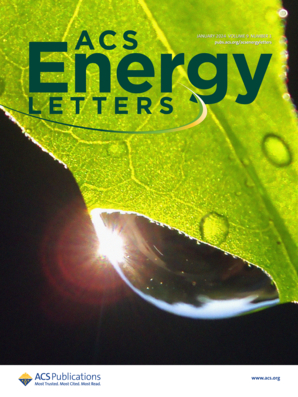Subzero Temperature Operation of Aqueous Zn Metal Batteries by Tailoring Electrolyte Solvation Structure
IF 19.3
1区 材料科学
Q1 CHEMISTRY, PHYSICAL
引用次数: 0
Abstract
The declining performance of aqueous zinc metal batteries (AZMBs) at colder temperatures, especially due to aqueous electrolyte solidification and reduced capacity retention at subzero temperatures, poses a considerable challenge. Here, we report a cheap and ecofriendly aqueous electrolyte formulation comprising low-concentration zinc chloride salt and a common antifreeze agent. We show that the glycerin antifreeze co-solvent effectively interacts with free water molecules and weakens the zinc-ion primary solvation structures, thereby considerably mitigating their detrimental effect at low temperatures. Consequently, the optimized electrolyte successfully outputs a depressed liquid–glass transition point down to −99.2 °C and a record-high Zn plating/stripping Coulombic efficiency of ∼99.94% at −40 °C, as well as ∼70% of its room-temperature capacity at −40 °C, opening up a new opportunity for practical AZMBs.

电解液溶剂化结构对锌金属水电池低温运行的影响
水锌金属电池(azmb)在低温下性能下降,特别是由于水电解质凝固和在零下温度下容量保持能力下降,这给电池带来了相当大的挑战。在这里,我们报告了一种廉价和环保的水电解质配方,包括低浓度氯化锌盐和一种常见的防冻剂。我们发现甘油防冻剂的助溶剂有效地与自由水分子相互作用,并削弱锌离子的初级溶剂化结构,从而大大减轻了它们在低温下的有害影响。因此,优化的电解质成功地将液-玻璃过渡点降至- 99.2°C,并在- 40°C下获得创纪录的镀锌/剥离库仑效率~ 99.94%,以及在- 40°C下其室温容量的~ 70%,为实用azmb开辟了新的机会。
本文章由计算机程序翻译,如有差异,请以英文原文为准。
求助全文
约1分钟内获得全文
求助全文
来源期刊

ACS Energy Letters
Energy-Renewable Energy, Sustainability and the Environment
CiteScore
31.20
自引率
5.00%
发文量
469
审稿时长
1 months
期刊介绍:
ACS Energy Letters is a monthly journal that publishes papers reporting new scientific advances in energy research. The journal focuses on topics that are of interest to scientists working in the fundamental and applied sciences. Rapid publication is a central criterion for acceptance, and the journal is known for its quick publication times, with an average of 4-6 weeks from submission to web publication in As Soon As Publishable format.
ACS Energy Letters is ranked as the number one journal in the Web of Science Electrochemistry category. It also ranks within the top 10 journals for Physical Chemistry, Energy & Fuels, and Nanoscience & Nanotechnology.
The journal offers several types of articles, including Letters, Energy Express, Perspectives, Reviews, Editorials, Viewpoints and Energy Focus. Additionally, authors have the option to submit videos that summarize or support the information presented in a Perspective or Review article, which can be highlighted on the journal's website. ACS Energy Letters is abstracted and indexed in Chemical Abstracts Service/SciFinder, EBSCO-summon, PubMed, Web of Science, Scopus and Portico.
 求助内容:
求助内容: 应助结果提醒方式:
应助结果提醒方式:


